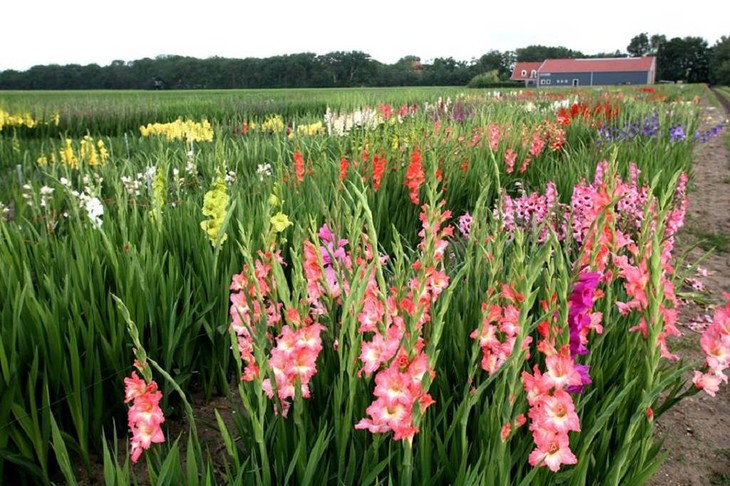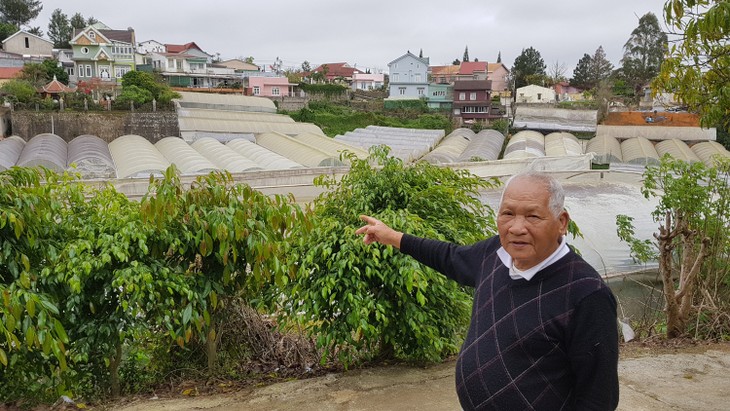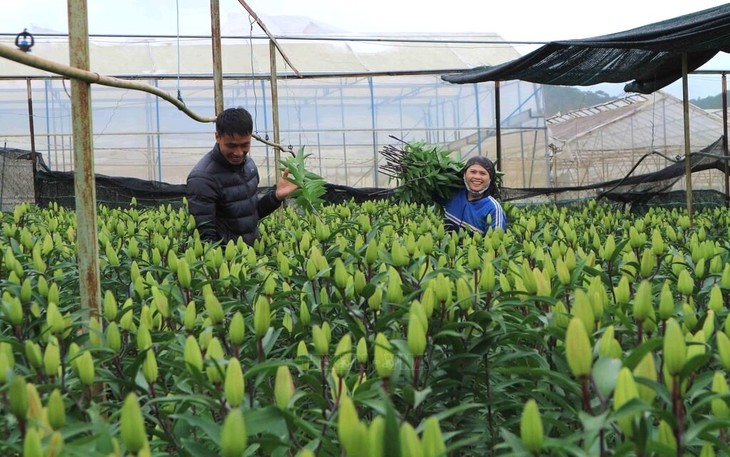(VOVWORLD) - Located at 1,400 meters above sea level and cool all year round, with an average temperature between 18 and 22 degrees Celcius, Da Lat city has been dubbed “the land of flowers”. It has developed large-scale flower villages that have their own brands.
 The Ha Dong flower village in Da Lat city (Photo: dalat.vn) The Ha Dong flower village in Da Lat city (Photo: dalat.vn) |
Ha Dong flower village in Da Lat city was established nearly a century ago by farmers who migrated from the flower-growing villages of Hanoi, to the Langbian plateau.
Vu Huu Xiem, a local resident, told us, “At that time there were only a few people in each village cluster. They came here to reclaim the land where there was just forest and mountains. At first, they grew mainly vegetables to supply the French.”
Ta Minh Quan, another resident, recalled, “The village’s name commemorates Hoàng Trọng Phu, a former governor of Ha Dong province. He said he was a Ha Dong native and wanted to give the village that name.”
The experienced farmers gave the wild, weedy hills a new look, with lush vegetable and flower gardens. Ha Dong hamlet became the first flower growing village in Da Lat. Tran Thi Be Thao, a local floriculturist, said their trees produce long-lasting flowers with brilliant colors.
“We used to grow anthuriums, then switched to growing orchids. Since orchids have become widely popular, we’ve developed some new ornamental plants, succulents, new orchid varieties, and flower and leaf trees for decoration,” said Thao.
 Vu Huu Xiem is the first generation of Ha Dong flower villagers (Photo: thanhnien.vn) Vu Huu Xiem is the first generation of Ha Dong flower villagers (Photo: thanhnien.vn) |
Following the success of Ha Dong, other flower villages have been started on Langbian plateau and are growing rapidly. In 1956, Thai Phien flower village was set up. Thanks to favorable natural conditions and abundant water from the streams flowing into Than Tho Lake, Thai Phien has become one of the largest flower growing areas in Da Lat, with 430 hectares.
Villager Bui Van Hoi, each person has their own growing technique and keeps it to themself. “It takes three months from planting to harvest. We need to monitor exactly how long it takes the flowers to bloom so that in the next season we can make them bloom at the right time – on the full moon day, on the first day of the lunar month, or at the holiday,” Hoi told VOV, adding, “It’s possible to earn 4,000 USD per 360 square meters of flowers, which is much more profitable than growing vegetables and helps us afford our children’s schooling and build a house.”
Van Thanh flower village is also widely known. Located in the heart of Da Lat, the village has retained its simplicity while contributing significantly to Da Lat’s economic development. Vu Hoang Anh, a local, said he has been familiar with flowers since he was a child.
“The golden age of Van Thanh village was in the 1990s when the market demand for flowers was quite high but the varieties weren’t diverse. Roses were almost the only flower available and much sought after in the market. Roses ruled over all other flowers,” according to Hoang Anh.
 A greenhouse garden in Thai Phien flower village in ward 12 of Da Lat city is in the harvest time of lilies. (Photo: NEWS) A greenhouse garden in Thai Phien flower village in ward 12 of Da Lat city is in the harvest time of lilies. (Photo: NEWS) |
Van Thanh flower growers have leveraged greenhouse technology and focused on breeding new varieties in addition to traditional flowers like roses, chrysanthemums, and carnations. They have experimented and produced new, rare flowers.
Nguyen Thi Kim Thoa recalled her parents moved to Lam Dong from the north to take part in land reclaimation and found the natural conditions suitable for growing flowers. “Some people grew chrysanthemums, others specialized in lilies or roses. We’ll do our utmost to continue the flower-growing heritage of our ancestors,” said Thoa.
Da Lat city has 4,000 hectares devoted to flowers, with an annual output of 1.5 billion cuttings, 400 types of flowers, and thousands of different varieties. In addition to growing flowers, Da Lat flower growers have started producing flower-based products including essential oils and teas.
Villages like Ha Dong, Thai Phien, and Van Thanh have contributed to the local economy through flower production and export and by attracting thousands of visitors each year who come to walk among the flowers and observe the local techniques of horticulture.